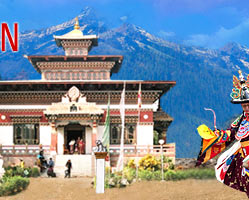Natural heritage of Bhutan is rich and diverse. Its forests occupy more than 70% of the country’s area and Bhutanese people have actively protected conserved and preserved their environment. In historical records, Kingdom of Bhutan was known as the ‘Valley of Medicinal Herbs’. It is due to the traditional reverence for nature that the ecosystem of Bhutan is still largely intact. Norman Myers included Bhutan in the list of ten bio-diversity hot spots in the world in 1998 and it has a significant place as the centre of 221 global endemic bird areas. Bhutan signed the Convention on Biological Diversity and United Nations Framework Convention on Climate Change in Rio de Janeiro in 1992 and the Royal Government of Bhutan has made a national commitment to preserve the culture and environment for its future generations along with sustainable development.
Bhutan has established a system of nine protected areas that covers approximately 26% of country’s total land area in national parks, nature reserves, wildlife sanctuaries and conservation areas. National Parks of the Kingdom of Bhutan are established to protect important ecosystems and not to be promoted as tourist attraction. The main protected areas of Bhutan are:
Jigme DorjiNational Park
Sprawling across4,349 sq km, Jigme Dorji National Park is Bhutan's largest sanctuary. Named after the third King of Bhutan, who is often referred to as the Father of Modern Bhutan, diverse species of flora and fauna flourish in this wildlife sanctuary. This national park covers the entire district of Gasa and the western areas of Thimphu and Paro districts.
Royal Manas National Park
Situated in the south central Bhutan, Royal Manas National Park lies to the north of Manas National Park in Assam, which is a World Heritage Site; and to the south of Jigme Singye Wangchuck National Park. Royal Manas was declared a wildlife sanctuary in 1966 and thus, has the status of being the oldest protected area in Bhutan.
Jigme Singye Wanchuck National Park
Sprawling across 1723 sq km, Jigme Singye Wanchuck National Park is the second largest protected area of Bhutan. Formerly known as the Black Mountain National Park, it has now been renamed after the present and fourth monarch of Bhutan. The Park boasts of a variety of habitats, vast tracts of primary forests and altitudes ranging from 200 m to 5000 m above sea level.
Phipsoo Wildlife Sanctuary
Sprawling across 278 sq km, Phipsoo or Phibsoo Wildlife Sanctuary is the only sanctuary in Bhutan that has natural sal forests and is a prime habitat of Chital deer or the spotted deer Axis Axis. It lies entirely inside Sarpang dzongkhag and touches the borders of Indian State of Assam in the south.
Thrumshingla National Park
The newest national park of Bhutan, ThrumshingLa National Park gained this status in July 1998. Sprawling across 768 sq km, it is situated in central Bhutan. It was in this Park that an image of a tiger was captured at 3000 m by a WWF-supported survey team in 2000. This photograph was the first evidence proving that tigers do exist at such high altitudes too.
Bomdeling Wildlife Sanctuary
Bomdeling Wildlife Sanctuary is situated in Trashi Yangtse district that lies in northwestern region of Bhutan. It covers an area of 1545 sq. km, out of which 420 sq. km is the buffer zone. It also covers parts of Lhuentshe and Mongar districts. The sanctuary touches Tibetan region of China in the north and India in the northeast.
Sakteng Wildlife Sanctuary
Sakteng Wildlife Sanctuary is an unusual one as it was created to preserve ‘Yeti’, the abominable Snowman known as ‘Migoi’ by the locals. There are no scientific proofs confirming the presence of this mythical creature that walks on two feet like humans and is tall and shaggy. There are many folklores and urban legends about this creature in the local Bhutanese people who insist that there have been many sightings of Migoi in this region.
Torsa Strict Nature Reserve
Torsa Strict Nature Reserve or Toorse Nature Reserve is situated in far west Bhutan. It sprawls over 644 sq km and covers two Dzongkhags of Haa and Samtse. It is the only Nature Reserve or protected area in Bhutan that is uninhabited by humans.
Khaling Neoli Wildlife Sanctuary
The smallest protected area in Bhutan, Khaling Wildlife Sanctuary sprawls across 273 sq km. It is situated in the Samdrup Jongkhar dzongkhag of the country and is an extended modification of the former Neoli Wildlife Sanctuary. Thus, it is also referred to as Khaling Neoli Wildlife Sanctuary.




